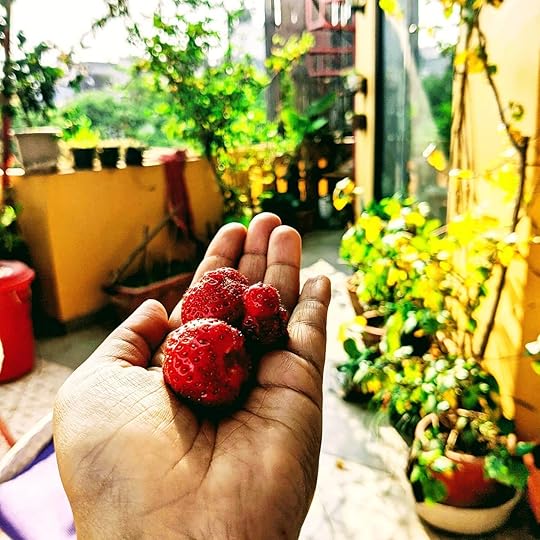Meenakshi Reddy Madhavan's Blog, page 31
March 3, 2021
The Internet Personified: Dear Enid
Greetings, Siberian Tigers of the Tundra!
It’s Women’s History Month and so this newsletter (E!) is very apt because of my subject. That reminds me though: I haven’t heard a word from any of you for the last three editions, is everything okay? Are you bored? Are you tired? Do you just want to read without the pressure of writing back? (I get it, me too.) Anyway, let me know something—anything—so it doesn’t feel like I’m writing into the Great Void. What do I do this newsletter for anyway if not to be constantly validated? (Only slightly joking.)
ANYWAY. Back to what I was saying, which is: it would be really hard to tell the story of my life without also mentioning Enid Blyton. I feel like she’s fallen somewhat out of fashion, whenever I stop off to buy books for my friends’ small children at bookstores I don’t see Enid anywhere.
 Enid, also wondering what the world has come to
Enid, also wondering what the world has come toSEGUE: A RANT ABOUT THE CHILDREN’S SECTION IN BOOKSTORES
Many a time I have been stuck at the last minute without a present and since I physically cannot go to a child’s birthday party without a present and since my presents are almost always books (this often pleases the parent more than the child I think but oh well, someday they’ll be happy with the books I give them) I used to stop off at the closest bookstore to pick out something for them. This is pre-COVID, you understand, when I could still browse in a small shop shoulder to shoulder with other patrons. Anyway, unless it’s a dedicated children’s bookstore (Bahri Kids is nice in Delhi and Lightroom in Bangalore is even better), the selection in most shops is terrible. Forget the more esoteric stuff (although would we call Pippi Longstocking esoteric?) there’s hardly any picture book classics, no Where The Wild Things Are or even The Cat In The Hat. It’s all 101 Stories About Ganesha and 20 Stories From The Ramayana mixed up with random Frozen merch. Not a Richard Scarry book in sight! Once, standing next to a father and a daughter, I heard him tell her to pick out a book of mythology, which is fine, everyone should know the old stories but must it be constant and must it be a chore and must it be the only thing your child is reading? I read wildly in my youth and only got to the myths when I was reading the Amar Chitra Katha comics to myself and I am now somewhat of an expert as you know so see, reading Enid Blyton or Astrid Lingdren in my childhood did not irrevocably corrupt me for everything else. It is a joy to be Books Auntie, sprinkling good things down on these kids and watching them discover Roald Dahl, for example, for the first time, but I have to do all my shopping in advance, from Amazon, which, as you know, is evil and killing authors and publishers with their heavy discounts.
/end rant
Enid Blyton made up my childhood. So much so that I can’t remember the first book of hers I read, nor the last. Every Blyton entered my life as though it had always been there: I had always roamed through the Enchanted Wood with Jo, Bessie and Fanny (changed I believe for modern children, now they are Joe, Beth and Frannie, as though kids will no longer be able to RELATE to a kid called Bessie or Fanny. Why are we pandering so much? Next they’ll change Jo in Little Women to Josie or something and then you’ll all cry.), I had always had a Wishing Chair in which I could fly to faraway places with Chinky the pixie (okay, I get why they had to change his name to Binky or Winky), I prepared to go to Mallory Towers or St Clare’s, I solved mysteries with Fatty and his friends, slipped the password to the Secret Seven, went for rambling nature walks with Uncle Merry and joined the circus with Mr Galliano. At age 5, I proclaimed, “I love reading Enid Blyton but I think I’m too old for her.” (This was recorded for posterity in a school magazine and all the adults laughed, while I was bemused. What was so funny?) I understood, see, at age 5, that there were books that would challenge you and help you grow, and let you learn things as you grew older, and there were books that were comforting and soothed you and would feel good to read, yes, but would let you stay in exactly the same space of reading development for as long as you liked.
Enid Mary Blyton always denied that she used ghost writers, but she wrote about fifty books a year. Okay, a lot of those were short fables and stories for children, but FIFTY. It seems impossible. By the ‘50s, people were already objecting to her work, it seemed too sexist, too racist, too unchallenged to still be in kid’s libraries. (I have just discovered there’s a BIOPIC starring HELENA BONHAM CARTER, must see if I can get a hold of it!) She was born to a salesman (of women’s clothes) Thomas Carey Blyton and his wife, Theresa Mary. Thomas is the one who instilled a love of nature in young Enid, so evident throughout her books, the robins chirp, the flowers bloom, the rabbits.. rabbit, but he left their family when Enid was thirteen to go live with another woman. She was never close to her mother, and she doesn’t seem to have forgiven her father either, she didn’t attend either of their funerals.
Bad mothers abound in Blyton’s books, but you have to look for them carefully. For example, in the books for younger children, The Faraway Tree series say, the mother is sketchily described. She’s always busy, she always has chores for the kids, which is fine, but she doesn’t seem loving at all. Jo will describe her as “fine” meaning “amazing,” Blyton’s children don’t bitch about their parents, but she doesn’t do anything to be particularly wonderful. Other mothers are harried (George’s mother in Famous Five, the only mother we meet) or socialite-y distant (Fatty’s mother) or spoilt (Gwendoline’s mother in Mallory Towers) or stern and scolding (Aunt Lou in a relatively unknown Blyton book which I happen to own, Come To The Circus.) Unloving mothers make an apperance also in Blyton’s standalone books, with slightly adult themes. In Six Cousins At Mistletoe Farm and its sequel Six Cousins Again, the story is about a whole country mouse-city mouse situation. Three farm children have to put up with their citified cousins coming to stay after their house burns down. These city kids are the worst, by the way. The older boy has long hair and recites poetry (shocking), the girl likes to dress up and wear perfume (even more shocking) and the youngest, the only redeemable one, bursts into tears a lot. Everyone shakes down and gets used to each other, but in the sequel, things are almost as bad if not worse, when the mother of the three city kids comes to run the farm next door. Now this woman married one sort of man, a sophisticated city man, who promised her a nice life, and expected of her only that she keep his house well, look after his children and look beautiful. Then he suddenly does a FLIP, and is all like, “Well, I guess I’ll be a farmer now and why can’t you be more like my brother’s wife Linnie, who is the EPITOME of a farmer’s wife and why must you have parties and why must you have a maid and breakfast in bed and make tiny little sandwiches and in all this, oh, our youngest kid wants a dog so you have to slap a smile on and look after that as well and I am zero use to you and no support except for telling you how much I like my brother’s wife, Linnie.” At the end of the book, the “spoilt” city wife has to agree to be a country woman and stand by her man etc and everyone applauds her decision, but still, it’s a pretty grim punishment.
In The Family At Red Roofs, a family is suddenly thrown into the wilderness when the father disappears at sea, and the mother, weak and soft, takes ill and can’t be told her husband is missing. It’s up to the two oldest children, fifteen and sixteen to make money and look after the house, and in all this there are two other terrible mothers: one, the mother of the two kids the older daughter is nannying and two, the mother of her school friend. One mother slaps and is irresponsible, the other constantly breaks down and fights with her daughter. “Gosh,” thinks Molly, our heroine, “I’m glad my mother isn’t like that” but really, her own mother is completely useless, and no one can lean on her at all.
Fathers are absent in Blyton’s world, either zooming in to give good advice and disappearing (Darrell’s dad, Malory Towers) absent minded and cross (Professor Quentin, Famous Five) or wrecked at sea (Red Roofs, above) or dead (The Adventure Series). So it falls to the mother to be everything: parent and minder and caretaker and captain of small souls and of course, they are inadequate, because Blyton says they are.
She herself had a troubled marriage. She married her editor, Hugh Alexander Pollock, who was already married with two sons (one living and one dead) when she met him and had to get a divorce to marry Enid. Between 1931 and 1935, she fell pregnant three times and had a daughter (Gillian), a miscarriage and then another daughter, Isabel in 1935. By this time, Hugh became a heavy alcoholic and also joined the army again, where he met a woman he had already known years ago, Ida Crowe (who went on to be his next wife and also romance and short story author, Ida Pollock. Hugh liked literary ladies.) Enid, in the meanwhile, had already started to loathe her husband, supposedly when he was wounded during some firing practice she refused to go see him because she was “busy and hated hospitals.” But all of this is coming from Ida’s memoirs, so we don’t know how biased it is. Ida also said Enid had a lesbian affair with one of her kids’ nannies as part of a long series of affairs and rounds of naked tennis? Nude tennis was apparently a thing, but it sounds painful to me, all those boobs and balls bouncing about. Anyway, she properly hated Hugh by the end of it, she threatened to take her books elsewhere if he stayed on at his publishing house so he was fired and couldn’t find a job anywhere else, she promised him access to his kids, which later she revoked and so he fell back into drinking and had to declare bankruptcy eventually.
In all this, Blyton was carrying on an affair of her own, with a man called Kenneth Fraser Darrell Waters (fun fact: Darrell Rivers from Mallory Towers was named after this guy). She married Kenneth as soon as she could, and changed her kids’ last names to his as well. It was an uneventful marriage, it looks like, marred only by the tragedy of Enid falling off a ladder and miscarrying their baby together, a son which they both longed for.
In her writing, she stuck to a schedule. A typewriter on her lap, a red shawl nearby (she liked the colour red, it stimulated her mind she said.) 6,000 to 10,000 words a day. The River of Adventure finished in five days. When she heard of a librarian claiming that she (Enid) hired ghost writers, she started legal proceedings against her. She was very proud of her output, and very upset that anyone should doubt her. She wrote, whatever you say about her, she wrote a lot, and came about her fame legitimately. Her kids existed in this postwar idyll, where nothing bad ever happened except maybe your parents got a little sick before they got well again. Except maybe your sister got trapped in a magic land over a tree and you had to go save her. Except that the village policeman might solve the mystery before you do, that your kidnappers will get away with everything before your cousins can run for help, you are never scared for your life, your biggest fear is that the bad guys will win. The darkest novels are The Adventurous Four series where actual Nazis are on the same island as the kids, and they have to get a message to “their guys” before the Nazis win.
You outgrow Enid Blyton all at once, one summer. Suddenly, the storylines seem babyish and trite. Why are these the concerns of fifteen year olds? Why are we still talking about British honour? You realise there are bigger themes in the world, and Enid only covers very few of them. It’s time for you to break away from her soft confinement, from her world where you are the “little foreigner” and you would be looked at suspiciously. Americans are brash, bold girls (they attend boarding school with Darrell in one school and the twins at another), Indians? Indians speak in gobbeldy goop and no one understands them. Any sort of foreigner doesn’t understand right and wrong and is to be scorned and pitied. You didn’t notice the golliwog stories—perhaps they were already scrubbed out of your books—but you noticed that. It’s when you learned to step out of her books, to look around you with cocked head and raised eyebrow, that’s when you knew you were ready for someone else.
POST SCRIPT: I have linked you to my speculative fiction versions of Malory Towers and Famous Five before, but in case you missed it, here are my two VERY DARK sequels to those books, called What Happened After. (I mean it, they are dark, I have lots of angry comments from people telling me I screwed up their childhood memories, so read at your own risk.)
What Happened After: Julian, Dick, Anne, George and Timmy the dog
What Happened After: Malory Towers
POST POST SCRIPT: The rest of the alphabet editions are here: A, B, C and D.
Links I Loved On The Internet:
I’m in this article about email newsletters in India.
I wrote a nice thing about Ann Patchett and the history of the dress she has on!
What do the Telegram groups of BJP leaders look like? (Depressing)
The children of elderly folks on QAnon. (Even more depressing.)
How brokers in Delhi and Mumbai keep Muslims out. (I’m sorry, it appears to be grim week over here.)
This is a very sad story about a dog which made both K and I WEEP copiously, but I would still urge you to read it because it’s so beautiful.)
Slightly more amusing: what it was like serving the right wing elite in the Trump Towers.
On the rules of literary fiction for men and women.
That’s all I’ve got! Speak to you very soon!
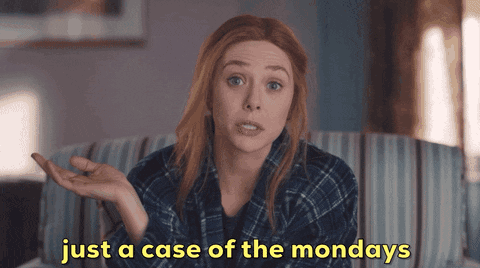 And then you realise it’s WEDNESDAY
And then you realise it’s WEDNESDAYxx
m
Where am I? The Internet Personified! A mostly weekly collection of things I did/thought/read/saw that week.
Who are you? Meenakshi Reddy Madhavan, writer of internet words (and other things) author of seven books (support me by buying a book!) and general city-potter-er.
Follow me on Twitter, Facebook and Instagram. (Plus my book recommendation Instagram!)
Got sent this newsletter? Sign up here to subscribe!
Forward to your friends if you liked this and to the authors you loved in your childhood before you realised how problematic they were if you didn’t.
Also, write back to me! I love to hear from you.

March 2, 2021
Today in Photo

Trying to perk up a boring errand and also the second day of my period with my 90s style beaded choker so I took this simpering selfie for you all. Plus then I dropped in on friends so it was worth it. #whatiworetoday
via Instagram

February 27, 2021
Today in Photo
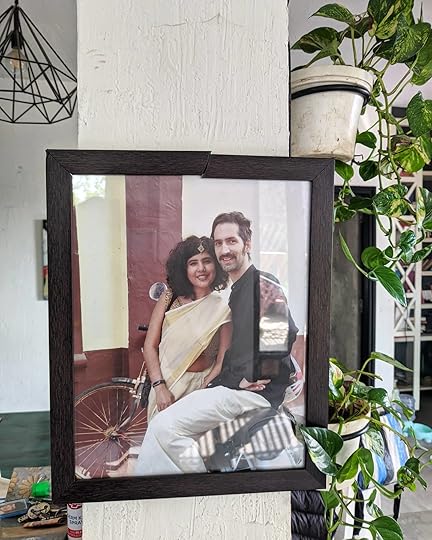
How nicely we match the house. (My father sent me this framed photo as part of my birthday present and it's the only wedding photograph we have, which isn't even FROM our wedding, just the Kerala party that happened the next year. Still the photo is nice, both of us looking extremely Mallu.) #framedphotographs #decor
via Instagram

February 24, 2021
Today in Photo
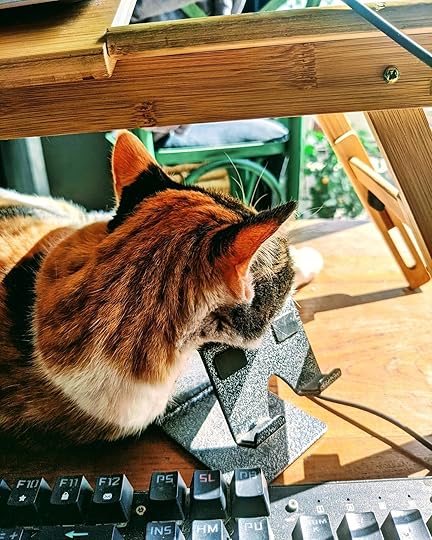
Gave her a little head stand so she'd stop sleeping on my keyboard. Now she's lounging about like a Roman Emperor. #catsofinstagram #olgadapolga
via Instagram

February 22, 2021
Today in Photo

You either love roses or you don't. They've gone from being a luxury to the most common flower to ever go into a bouquet. The "red red rose" is offered to you at every streetlight, tightly wrapped in plastic. What's so special about that? Also Valentine's Day, love etc. It's kinda... Basic. But did you know the reason the red rose is associated with St Valentine is because of Christ? The rose has sharp and ancient Christian connotations. It begins with Mary in medieval art in her rose garden, a symbol of Eden and also a popular courting place, your Lodhi Gardens of ancient times. Then Christ wore a crown made of rose thorns, and the red rose in particular was associated with love and matrydom. From there, the rosary beads arose, a garland of roses, a set of prayer beads. Further back, the Romans hung a rose upside down from the ceiling to indicate a private meeting - - leading to all private meetings in the future being referred to as "sub rosa." isn't that cool? Don't you look at roses differently now? Here's a pink rose, the symbol of friendship, from my garden to you, so we can always be friends. #historyofflowers #pinkrose #roses #terracegarden
via Instagram

February 21, 2021
Today in Photo

Lady Olga da Polga (of the Russian da Polgas, one of the oldest and best families) was never too busy to attend to her toilette after a long day. This day had been particularly long, she had to fend off the advances of the visiting Sir Moonface who occasionally stood outside her door, begging for admittance, she had to tend to the cottagers around her estate as her mother had before her and she had to have her grooming in order before the upcoming Season. It was no wonder that by the end of the evening, she preferred to be alone, to undress and bathe in private, while contemplating the heavy tasks that lay ahead of her. #regencycats #olgadapolga #catsofinstagram
via Instagram

February 19, 2021
Today in Photo
February 15, 2021
What I'm Reading

It's hard to believe that the finest sentences I've read in a long time, sheer poetry in paragraphs, lines so good I'm reading them twice and saying, "Listen to this" to K are coming from a murder mystery police procedural with a cover like that. I mean, not to be snobby about genre fiction, I love it, I do, Tana French is a star, Agatha is a high priestess, some of the best books I've read have been murder mysteries but sometimes writing is sacrificed for plot. Not in this case. Listen to this: "It was a nice place but it bothered him in the way houses that have been made self-consciously attractive always did. The whole experience, the talk that had lost all awareness of its own arbitrariness, the carefully arrived at prettiness of the rooms, was like being trapped inside somebody else's hallucination." He's dead, the author, there are only three Laidlaw books (TARTAN NOIR) and you must read the first one, at least, immediately before deciding to purchase all three for your shelves. #bookstagram #nowreading #mrmbookclub #121in2021 #laidlaw #williammcilvanney

The Internet Personified: I know who I want to take me home
Dearest Tender Coconuts,
What’s the name for a booze shop where you are? Like any good Delhiite, I say “theka” but I know what it means when K calls it an “off-license.” In Bombay, it was the fancy “wine shop” as in “There’s a wine shop down the road that delivers past midnight.” If I know my American pop culture, I think they say “liquor store” which also sounds fancy. Actually, everything sounds fancier than “theka” which, I literally just learned from Quora, means “licensed” so basically K and I are saying the same thing in different languages! This is like that Colin Firth storyline in Love, Actually, any minute now K will have to dive into a pond to rescue the typed pages of my manuscript which I have foolishly not made a back-up of, I will be so moved, I will go to his little German village and ask his father for his hand in marriage even though neither of us understands what the other is saying. Who needs WORDS when you have LOVE and other ridiculous things that movies would have you believe are True Feelings.

This is the Internet Personified, these are the alphabet series, and today I’m leading you down the Merrie Roade of Drinke, because that’s right, it’s D is for drinking.
Like everyone you know, maybe even you, I started experimenting with alcohol in high school. It wasn’t that hard, the thekas don’t ID you, even if you do look a bit sneaky and a bit giggly while you do it, and once we drank a whole bottle of Lady Di1 gin, in my friend’s bedroom while her parents were at work and my other friend got so sick we had to stick her in the shower and give her lemons to suck on, because we heard lemons sober you up. Later, I would avoid gin for many years until I re-discovered it in my thirties just remembering the sickly sweet smell of that Lady Di mixed with Sprite, because we thought light drinks should only have light mixers. I’ve never liked Sprite though.
At high school parties, I chose vodka, but frankly, I’d have drunk whatever was given to me, no matter how distateful I found it. Once, rebelling, I went to the home of a friend of a friend, a little room that this friend of a friend had rented for themselves (he was not much older than me, and we were six people in the room, so it’s not as shady as you might imagine) and he had no drinking water—he’d have had to buy water or boil it—but he had six cans of extremely cold beer, which he offered to me, and which I drank, throat moving gulpgulpgulp not tasting it at all, but it was so cold and so refreshing. I’ve never liked beer, but I remember the feeling of thirst quenched.
A pleasant high, that’s what I went for. A mild buzzing in my head, a slight tilting of the world as I stood up. I was not getting drunk in high school, and if it came down to it, I usually finished my night off with just a straight up Pepsi or Fanta.

It had never been that much fun before at high school parties—primarily because the school I was at for classes 11 and 12 was huge, and so going to a party was seeing two or three people you know. I was “dating” a boy from a different school, so I didn’t even have reason to enjoy going to these parties, the one or two I was invited to anyway. They all seemed like more of the same, a lot of people talking about a lot of people I didn’t know, and me, awkwardly in a corner, attempting to be light and funny and cool. (Come to think of it, not a lot has changed. Hmm.) I had two friends I hung out with, they were sometimes more dazzled by the experience than I was. All Delhi schools have this one tradition of the “conti” party, not “continental” you understand, but “continuation” like a continuation of your graduation. We didn’t have one single graduation ceremony, because all of our final board exams finished on different dates, but all schools had the eleventhies throw a party for the twelfthies. I don’t remember ours, but I do remember that I got asked to the CJM-Colomba’s2 conti party because of my various friendships across the city, quite a coup for me. I remember going too, because I had to sneak around and do it. Not the actual party, but the sneaking around stays firm in my memory.
Then? College. That’s where I learned to drink socially, as a way to connect and bond. I was still much younger than Delhi’s legal drinking age (25) but right next to our college was a cheap bar called The Supper Factory (they tried very hard to become a cool acronym—TSF!—but the most we could summon up for it was Supper.) It was a restaurant which served cheap drinks, so I don’t want you to imagine a bar. Imagine instead white and blue lighting, cheap plastic wicker tables with glass tops, four chairs to a table and sticky-feeling fake leather bound menus. I don’t remember what food they served, but they all served Indian Chinese. It seems to be the rule across the country, you want cheap drinks, you’ll get chilli chicken dry on the side. The Supper Factory had a morning deal, for alcoholics and young students at the women’s college next door—happy hours till 2 pm, two-for-one vodka shots at 40 rupees. I got so far behind on my attendance in my second year at college they had to send a letter home, all because someone or the other would suggest The Supper Factory at even the slightest hint of boredom. We were never bored now that we discovered liquor. Study sessions, four of us best friends or as close as, by the time the big hand and the little hand both met in an over the head namaste at noon, someone would say, “Oh, is it noon?” and someone else would break out the vodka, the friend whose house we studied at went downstairs for the mixers and the ice. “After all,” she’d say as I’ve mentioned before, “If it’s after twelve o’clock, we’re not alcoholics.”
My History of Drinking should really be tied up with my History of Sex. Many bad decisions, some of which, mercifully, I can no longer remember. Some close calls, for a young woman in Delhi, drinking as I did, till I had “fragmentary blackouts3” I survived to tell the tale about it. Sometimes my body just took over, I remember weakly saying “No no” to a pushy boy at a party and he kept pushing and saying, “Why not?” until I said, “Because I have to puke” and promptly did and he promptly left me alone. No one wants to kiss a vomity mouth, thank god. Another time, I only managed to get the man off me because he was too drunk to do anything other than vomit once I shoved him. Still, it was scary and burnt into my memory as you can see from the fact that I still remember.
It got to be a lot. I was always skirting close to disaster, and never reaching it. For many years, my late teens and my twenties, I drank to excess more often than not. My strong young body kept off hangovers for many years, and I could sleep for only two hours and wake up looking as fresh as a daisy. One of the scariest fragmentary blackouts I had was in Goa, with two other friends, when the last thing I remember was vomiting my several tequila shots into the bushes, just projectile vomiting everywhere, and then I woke up the next morning in my bed, one of my friends curled up at my feet. We tried to reconstruct what happened to us, but we were so sick, the hangover lasted two days, that we could barely put a sentence together. And I was with a very controlling man, who discovered my activities all the way from Bombay and everyone was very disapproving, complete strangers at our Goa hotel were looking at us like they’d never in their whole lives seen such unladylike behaviour. At least we got back to our hotel, in one piece, the only disaster being our terrible hangovers (and some tsk-tsk-young-people lectures.) Was that the last time I had a tequila shot? It might have been.

I frightened myself sometimes, so I began to ease off a bit. Maybe not get drunk every weekend. Maybe learn to love red wine and pour your own drinks at a party so you can control how much goes into them. Maybe put down your glass for a while and wander off in search of water and something to eat before you return. I still got drunk, but I learned to recognise the Right Before The Edge symptoms and stop. I no longer enjoyed sticking my finger down my throat to vomit so the room would stop spinning. (Okay, no one enjoys that, but as a life skill it does sober you up somewhat.) I was on the brink and I turned away, as many of my friends were doing, unbeknownst to me, and suddenly, when you went out for drinks with your friends, there’d be a point before last call, before the bar had to physically shove you out into the night with your takeaway cup, where someone would say, “I’m done, I should go, early morning tomorrow” and you’d find yourself agreeing, and you’d pay the bill and go home before midnight like civilised people. Or you’d be partying and someone would offer to buy you a shot and you’d look down at your half-full glass—a mojito maybe, you love mojitos—and you’d say, “Nah, thanks, I’m good” and they’d move on. Maybe once in a while you’d still go to TGIF with your friends, where they had a 1+1 Happy Hour on everything, and their Ultimate Margarita was the size of your head, and cost 500 bucks so if you went out with 1000 rupees in your pocket you could get four and be as drunk as a lord. The serving staff was downright rude by the end, you’d sit there for so long, four to a table, eking out your drinks as long as they took.
Now I’m a grown up, someone I might have called boring in my own youth, I know my four stages of drunkeness: the Chatty (everything is interesting and I have so much to say!), the Bolshie (wow, you are all SO WRONG about everything and I might call you all assholes in a loving yet firm way), the Maudlin (who will cry when I die?) and the Tired (k, I’m ready to go home now, I have hit the wall, if people keep talking to me they will encounter glazed eyes and a fixed smile like a robot.)
Anyway, tell me your tales—cocktail recipes, stories of drunkenness, your “I’m never drinking again” fables, I want to hear them alllll.
Have you seen that Substack now allows FOOTNOTES? Mine are at the bottom of this thing if you click the footnote number next to the word on top. It seems you can only view them in the web version though (boo) so click on the title of this newsletter to go to the browser edition.
Also please tell your friends about this newsletter if you haven’t already because it’s nice to know that people like it and tell other people to like it.
PREVIOUSLY on The Internet Personified Alphabet Editions:
C is for crush.
Links I Liked On The Internet:
I wrote this for The Voice of Fashion about bras and Mrs Srivastav, the Collector’s wife from English, August.
After reading this profile, I immediately began following @deuxmoi, the Instagram gossip account.
Related: ten long years of trying to make Armie Hammer happen.
The roommate from hell story.
Trying to do some research on all those gross fast cooking recipe videos that pop up everywhere.
Beautiful story about a little amusement park designed especially for children with terminal diseases by a Holocaust survivor. (I see Tom Hanks as a great lead for the eventual movie.)
Jeff Bezos and the Amazon-y world.
Ultra fast fashion is eating the world.
Lovely essay by Annie Zaidi about how consensual love is basically hated in India.
Palate cleansers:
Five facts about birds.
Bats are the new cats and I love them.
Have a great week!
xx
m
Where am I? The Internet Personified! A mostly weekly collection of things I did/thought/read/saw that week.
Who are you? Meenakshi Reddy Madhavan, writer of internet words (and other things) author of seven books (support me by buying a book!) and general city-potter-er.
Follow me on Twitter, Facebook and Instagram. (Plus my book recommendation Instagram!)
Got sent this newsletter? Sign up here to subscribe!
Forward to your friends if you liked this and to the hangover you now get after one measly gin and tonic if you didn’t.
Also, write back to me! I love to hear from you.
Okay, so the gin was not called Lady Di, I don’t think. It was royalty definitely though. Duchess? Queen? Or just plain old Blue Moon, still beloved by dive bars across India.) (Don’t drink it, it’s terrible and will ruin you.
2St Colomba’s is a very popular Catholic boys school which shares a boundary wall, as many single sex schools do, for whatever strange reason, with the Convent of Jesus and Mary, a very popular Catholic girl’s school. They were called the “brother-sister” schools, Columba’s actually shared this honour with CJM and one other girl’s school, so they got two Conti Parties, but the CJM one was widely acknowledged to be the funner, “more happening” one.) (The St. Colomba’s boys—at least, the few I knew—had a particular honk they used to announce themselves—beep beepbeep beep beep, which was supposed to correspond to “pakad pakad ke chodh do” or “catch ‘em and fuck ‘em” for my non-Hindi speaking readers, so you have some context for them now. Imagine big cars exuding Isseymikayi for Men and cigarette smoke fumes rolling up to your door and beep-beepbeeping.
3A note on fragmentary blackouts, in case you’re curious:
The two types of alcohol-induced blackouts, en bloc and fragmentary, are very different from one another and are not to be confused with passing out — an experience of falling asleep or going unconscious after drinking alcohol. In en bloc blackouts, a person experiences a complete loss of memory for the drinking episode; they are often awake and functioning but have no memory of their actions the next day. Perhaps even more frightening is the fragmentary blackout, which involves partial memory loss, sometimes retrieved with cues; leaving a drinker to piece together bits and pieces of hazy information from the night before.
Blackouts occur at high rates among social drinkers and binge drinkers, alike; but one of the largest groups impacted by blackouts is college students.

February 14, 2021
Today in Photo
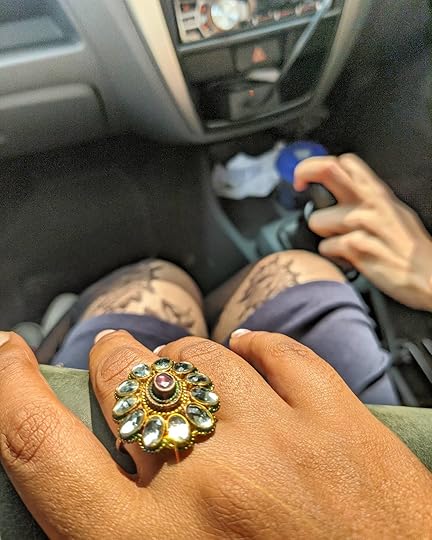
I forgot to show you my ring from yesterday! It was lying at the bottom of my jewel box and I suddenly saw it like a shiny thing at the bottom of a pond and put it on immediately. Man, my hands look damn old in this photo also which I took because I liked the sparkle of the sunlight against the stone. You can never hide your age from your hands. Everywhere else, fine, there's Korean skin care and surgery but AFAIK there's no such thing as a Hand Lift so here's all my thirty nine years of living showing on my skin. #shinythings #whatiworetoday
via Instagram


